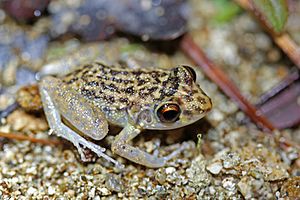Eleutherodactylus simulans facts for kids
Quick facts for kids Eleutherodactylus simulans |
|
|---|---|
 |
|
| Conservation status | |
| Scientific classification |
The Oriente mottled frog (scientific name: Eleutherodactylus simulans) is a special type of frog. It belongs to the family Eleutherodactylidae. This frog is found only in Cuba, meaning it is endemic to that island. It was first described by scientists Diaz and Fong in 2001.
Contents
What is the Oriente Mottled Frog?
The Oriente mottled frog is a small amphibian. It gets its name "mottled" from its spotted or blotchy skin pattern. These patterns help the frog blend in with its surroundings. Like all frogs, it starts its life as a tadpole. Then it changes into an adult frog.
Where Does It Live?
This frog lives in specific places in Cuba. Its natural habitats are warm, wet areas. These include subtropical or tropical moist lowland forests. It also likes to live near rivers. These places provide the perfect conditions for the frog to thrive. They offer plenty of moisture and food.
What Does It Eat?
Oriente mottled frogs are carnivores. This means they eat other small creatures. They usually hunt insects and other tiny invertebrates. They use their long, sticky tongues to catch their prey.
Why is the Oriente Mottled Frog Important?
Every animal plays a role in its ecosystem. The Oriente mottled frog helps control insect populations. It also serves as food for other animals. This makes it an important part of the food web in Cuba.
What Threats Does It Face?
Sadly, the Oriente mottled frog is in danger. It is listed as an endangered species. The biggest threat to this frog is habitat loss. This happens when the forests and rivers where it lives are destroyed. People might cut down trees for wood. They might also clear land for farms or buildings. This takes away the frog's home. It also reduces the places where it can find food. Pollution of rivers can also harm the frogs.
How Can We Help?
Protecting the Oriente mottled frog is important. Efforts are being made to save its habitat. This includes setting up protected areas. These areas keep forests safe from being cut down. It also means keeping rivers clean. Learning about these frogs helps too. The more people know, the more they can help protect them.
See also
 In Spanish: Eleutherodactylus simulans para niños
In Spanish: Eleutherodactylus simulans para niños


